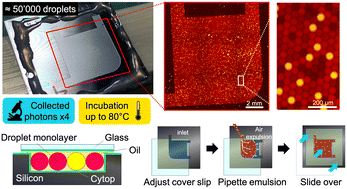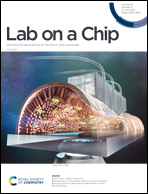Silicon chambers for enhanced incubation and imaging of microfluidic droplets†
Abstract
Droplet microfluidics has become a powerful tool in life sciences, underlying digital assays, single-cell sequencing or directed evolution, and it is making foray in physical sciences as well. Imaging and incubation of droplets are crucial, yet they are encumbered by the poor optical, thermal and mechanical properties of PDMS, a material commonly used in microfluidics labs. Here we show that Si is an ideal material for droplet chambers. Si chambers pack droplets in a crystalline and immobile monolayer, are immune to evaporation or sagging, boost the number of collected photons, and tightly control the temperature field sensed by droplets. We use the mechanical and optical benefits of Si chambers to image ≈1 million of droplets from a multiplexed digital assay – with an acquisition rate similar to the best in-line methods. Lastly, we demonstrate their applicability with a demanding assay that maps the thermal dependence of Michaelis–Menten constants with an array of ≈150 000 droplets. The design of the Si chambers is streamlined to avoid complicated fabrication and improve reproducibility, which makes Si a complementary material to PDMS in the toolbox of droplet microfluidics.



 Please wait while we load your content...
Please wait while we load your content...